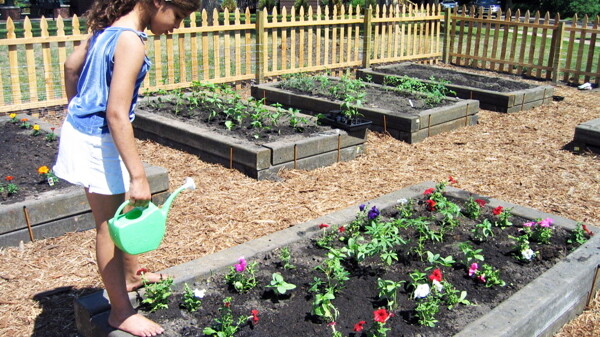Back to the Garden
community gardens a growing trend in Eau Claire

Community gardens are literally sprouting up everywhere (pun intended). There are six community gardens already flourishing in Eau Claire – quite a few for the city’s size. Two are kids’ gardens used for educational purposes by UW-Extension, while four others allow community members to rent plots.
One of them, Lakeshore Community Garden, will begin its second growing season this summer. Laurelyn Sandkamp, one of the major organizers of the garden, says the process first started in October 2012. Through the Clear Vision Empowerment Summit, a variety of work groups were formed, one of them focusing on expanding community gardening. The group partnered with the Historic Randall Park Neighborhood Association and the city Parks and Recreation Department, since the proposed garden plot was on city-owned land. The proposal had to be approved by the City Council, but Sandkamp describes it as a straightforward process. “We started conceptualizing the idea of a garden in October 2012, and by late May of 2013 we had already broken ground and started gardening,” Sandkamp says. The work group was led by Kerri Kiernan, who had experience starting community gardens and served as a coach.
“I’m passionate about community gardens because it’s a way to bring people together around food.” – Laurelyn Sandkamp, Lakeshore Community Garden organizer
Getting the 14 plots in the Lakeshore Community Garden filled was done completely by word of mouth, without any formal advertising. Ten different groups filled the plots, ranging from retirees to families with small children to college students to people just looking for something to do. A huge variety of plants were grown, including Japanese eggplant, tomatillos, watermelon, chamomile, kale, basil, and zinnias.
While helping to lead the project and get it started, Sandkamp also participated in the gardening process, sharing three plots with several other university students. (They included this article’s author!) “I enjoyed every minute of it,” Sandkamp says of her experience. “I had worked on an organic farm before … but this was totally new. This was a lot smaller scale. I really had the freedom to try whatever crops I was interested in.” Sandkamp first became involved with community gardens in the spring of 2010, when she helped out with the beginnings of the Phoenix Park Community Garden (now the Forest Street Community Garden).
The other gardeners really enjoyed the experience, too: This year, 10 of 14 plots are being rented by repeat gardeners. After the last gardening season, Sandkamp surveyed participants. Ninety-two percent said they felt more involved in the neighborhood, 75 percent said they ate more organic food, and 75 percent said they spent less money on food. That’s quite an impact!
One respondent said: “This was the first year I have ever planted and tended a vegetable garden myself, and I couldn’t have asked for a better first-year experience.” Another says, “The location is amazing. It is incredibly accessible not just to us as gardeners but for the public to see and witness the evolution of the garden throughout the year.” Being right next to a bike path made the garden a very visible new addition to the neighborhood, which helped foster a new sense of community closeness.
Helene Smiar was one of the major players in the ground works of the Lakeshore Community Garden as well. She helped them get the approval of the Randall Park Neighborhood Association, which helped the project to get started. Smiar does many of the administrative and supervisory tasks for the garden. Yet she says, “If it weren’t for the enthusiasm of Laurelyn and Kerri, it would not have gotten started.”
When asked why she has so much enthusiasm about the topic, Sandkamp replied, “I’m passionate about community gardens because it’s a way to bring people together around food. Because food is something anyone can identify with. Everybody loves food. We all need food, we all need healthy food. And community gardens are a way to bring people together around that, in a nourishing and sustainable and empowering way.”
It seems like community gardens really are becoming trendy. “People are interested in the source of their food,” Sandkamp says, “and they want to get as close to the source of their food as possible, whether that’s participating in the farmers market, participating in CSA (Community Supported Agriculture), (or) looking for the local label at the grocery store. … People just want that now, and people want to be able to grow their own food. Because that’s a skill that has sort of been lost, not lost, but fewer people know how to do it now, and I think there’s a strong interest in relearning those skills.”
To learn more about community gardening, visit www.eauclairewi.gov/departments/recreation-services/parks/eau-claire-community-gardens






















